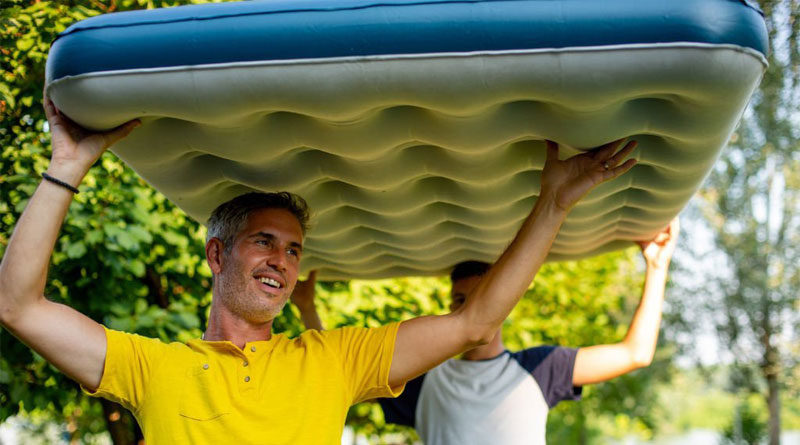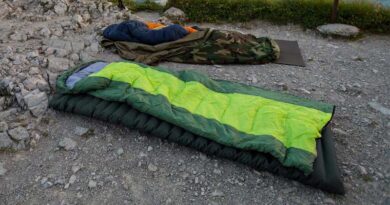Sleeping Pad vs. Air Mattress: Which is better?
Comfortable sleep is important during your outdoor adventures. Sleeping pads and air mattresses both provide comfort in a sleeping system by lifting you off the ground. Both add padding and cushioning so that you don’t the hard ground beneath you.
While both, pads and mattresses, have the same function, they are not the same. There are upsides and downsides to carrying both. So, which one is better for you?
The short answer is that a sleeping pad is better in the long run as it is more durable and versatile than an air mattress. But air mattresses also have their place and they are good for family camping or car camping trips.
But let’s get into the details of how both of them compare to each other.
Comfort
Air mattresses have a large surface area to sleep on. They are also very thick keeping you high above the ground and also giving you more room to adjust the firmness of the mattress. With blankets and pillows, you can make an air mattress seem like a real bed at home.
Sleeping pads, on the other hand, have a small surface to just fit an average-sized person. If your dimensions are unusually generous, then you would have a hard time finding a pad for yourself. Even if you do, you would have to pay extra for that larger size.
Sleeping pads are also very thin. Foam sleeping pads provide insufficient cushioning. Air pads are more comfortable than foam pads but they are still thinner than air mattresses. The thin height of air sleeping pads gives you a lot less room to adjust the firmness and provides less cushioning than an air mattress. Side sleepers and people who like to sleep in weird positions would have a hard time on a sleeping pad. Learn more about foam and air pads here.
In terms of comfort, then, air mattress has a clear advantage.
Warmth
Sleeping pads are made to function in the outdoors. The fabric and reflective surfaces used in sleeping pads keep them warm. Each sleeping pad has an R-value assigned to it which is the measure of its insulation or how much warmth it can retain (pads don’t generate warmth). R-value ranges from 0.5 to 8. The higher the R-value, the warmer the pad is.
A sleeping pad for summer camping such as the Klymit Static V2 has an R-value of only 1.3 while a sleeping pad for cold weather such as the Therm-a-Rest NeoAir Xtherm has a higher R-value of 7.2. Foam pads have a lower R-value of 1 – 2 while air pads have a wide range of R-values.
Air mattresses don’t have an R-value and they are not made to retain body heat. The temperature rating depends on ambient temperature. An air mattress may work during the summer, but during winter it can become extremely difficult to stay warm. Its large surface area further contributes to the problem.
To stay warm on an air mattress, you would have to bring some extra stuff like sleeping bags, foam sheets, mattress toppers, etc. Since mattresses are heavier, to begin with, bringing extra stuff to stay warm would only increase your baggage.
Weight and Pack Size
As mentioned above, air mattresses are heavier than air pads. They have a larger size which contributes to their heavier weight but they are also heavier to carry. The size of an air mattress ranges from two persons to king size.
They were never designed to be put in a backpack on your back for several miles. The average weight of a two-person air mattress is 8.5 pounds while the average weight of a king-size air mattress is around 13 pounds. Due to their large size, it is difficult to fit air mattresses in a tent as well.
The materials used in the manufacturing of air mattresses are not lightweight. The larger size of an air mattress not only means it is heavy but also means that its pack size is larger as well. A larger size also means it is difficult to inflate them.
Air mattresses either come with a pump or you would have to get one. If you try to inflate an air mattress using your lungs, you would find out quickly how big of a mistake it is. Small mattresses come with a hand or foot pump while larger ones come with pumps that require electricity making them suitable for car camping.
Carrying air pumps along with extra insulating stuff to keep you warm as mentioned above would increase the overall weight you would have to carry with an air mattress. Needless to say, you can’t take an air mattress on a backpacking trip unless it’s a group setting and where someone carries your stuff.
Sleeping pads are made specifically for backpacking. The materials used in the construction of pads are extremely lightweight. They are also made to pack to a much smaller size. Many air pads pack down to the size of a 1-liter water bottle. While foam pads don’t pack as small air pads, they still pack way smaller than air mattresses and can be attached to the outside of the backpack leaving more space inside.
The average weight of sleeping pads is around a pound. The thickest air pads you can get like the Exped MegaMat Lite 12 weigh close to 3lbs. An ultralight air pad like the Therm-a-Rest NeoAir UberLite weighs only 8.8oz. Self-inflating foam pads are the heaviest of the sleeping pad types and also pack similar to foam pads.
Durability and Reliability
Air mattresses have a reputation for leaking and random bulging. Their valves tend to fail quickly as well. They are also susceptible to punctures. The price of the mattress plays an important role in determining its durability but some people say their air mattresses held up for years while for others, their mattresses won’t retain air after only one trip.
While air pads and self-inflating are susceptible to punctures as well, they are still more durable than air mattresses. The fabric used in the construction of these pads is often thicker having a higher denier number. The denier number is the measure of the density of fibers. The higher the denier number the stronger the fabric will be.
But regardless of an air mattress or pad, you would have to keep a patch kit in case they get a puncture. Similarly, both air pads and air mattresses can fail suddenly so it’s always a good idea to keep a backup with them.
Foam pads, on the other hand, are very durable and reliable. They do not fail suddenly and can function even when ripped or chewed by a grizzly bear. You don’t have to worry about punctures with a foam pad so you won’t have to waste time clearing the campsite.
Versatility
Air mattresses are not versatile at all. In fact, you would have to be very careful while using an air mattress as to not puncture it. They can’t be used in any other activity but for sleeping. You would have to be careful while choosing a campsite and then clear the campsite further for any pointy things that may puncture the mattress.
Air pads and self-inflating sleeping pads are the same as air mattresses. But foam pads are a different thing altogether. Foam pads are the most versatile sleeping pads. Since you don’t have to worry about them getting punctured, you can use them for a lot of things.
Foam pads can be used as floor mats on rocky and rough surfaces. They can also be used as panels for frameless backpacks. Some foam pads like the Therm-a-Rest Z Lite SOL are made of one-ounce segments. These segments are easy to separate and can be used as support structures like splints for fractured bones.
Price and Value
Air mattresses cost less than sleeping pads. You can get a good quality sleeping mattress of a decent size for around $100. But sleeping pads cost a lot more. They can cost somewhere around $20 for basic foam pads to $400 for self-inflating and premium air pads.
But of course, sleeping pads provide more value for the price. They are lightweight, easy to carry, pack tight, are more durable and reliable, retain body heat, and are versatile. Air mattresses are comfortable, but they are heavy, unreliable, and don’t last long. They are also hard to stay warm on.
Summary
| FEATURE | SLEEPING PAD | AIR MATTRESS |
|---|---|---|
| COMFORT | Not very comfortable | Comfort is a strong point |
| WARMTH | Retains body heat based on the R-value | Air mattresses don’t have an R-value and don’t retain body heat at all. Don’t use them in cold temperatures |
| WEIGHT | Made for backpacking and very lightweight, mere ounces | Very heavy |
| PACK SIZE | Extremely small pack size. Some pack down to the size of a 1-liter water bottle. | Very large pack size. Can’t be stored in a backpack. |
| DURABILITY | Foam pads are very durable. Air pads have a high denier fabric making it resistant to punctures. | Not durable at all. Can be punctured easily. Cheap models even lose air or bulge randomly. |
| RELIABILITY | Foam pads are extremely reliable while air pads do have reliability issues | Not reliable at all |
| VERSATILITY | Very versatile. Some foam pads can be used as support structures as well. | There is no versatility. You have to be very careful while using them. |
| PRICE | They can be very expensive. Premium ones can be above $400. | They are cheap. Even the good ones can be found for under $100 |
| VALUE | Provide more value for price as they provide warmth and support in case of foam pads | Don’t provide much value. |
| BEST USE | Backpacking, UL backpacking | Camping, car and family camping |
Which one is better for you?
If you look at the overall comparison, sleeping pads are obviously better. They are specifically designed for outdoor use while air mattresses are not. If you are someone who frequently participates in outdoor activities under varying circumstances, then a sleeping pad would be a better option for you.
Sleeping pads are easier to carry, more durable, and versatile than air mattresses. Although they lack the comfort of an air mattress, they do provide reasonable warmth. If you are planning a camping or car camping trip with family, an air mattress is a better option due to its comfort. But do keep in mind that your mattress would be cold during cold nights. It is only good for mild or summer nights.




